Episode #400: From Lofty to Laser-Focused: Unpacking One District’s Math Improvement Plan
LISTEN NOW HERE…
WATCH NOW…
In this episode, we share how one district is entering the new school year with a sharper focus in their Math District Improvement Plan. In the past, they worked from three ambitious objectives—each rooted in big ideas for strengthening math instruction. But progress unfolded more slowly than anticipated.
This year, the team decided to narrow their efforts to one math-specific objective. They designed short-term, measurable key results to monitor progress by February, rather than waiting until year-end. The result? A focused plan that aligns with instructional goals, works within the reality of competing demands, and builds momentum early in the year.
Tune in to hear how this shift helps the district center its energy on what matters most: improving student learning in mathematics.
In this episode, you’ll discover:
- Why narrowing to one math objective can accelerate change
- How short-term key results keep teams grounded and focused
- What it looks like to plan realistically without losing ambition
- How this district balances math priorities with cross-departmental demands
- The power of focus in multi-year math improvement efforts
Attention District Math Leaders:
Not sure what matters most when designing math improvement plans? Take this assessment and get a free customized report: https://makemathmoments.com/grow/
Ready to design your math improvement plan with guidance, support and using structure? Learn how to follow our 4 stage process. https://growyourmathprogram.com
Looking to supplement your curriculum with problem based lessons and units? Make Math Moments Problem Based Lessons & Units
Be Our Next Podcast Guest!
Join as an Interview Guest or on a Mentoring Moment Call
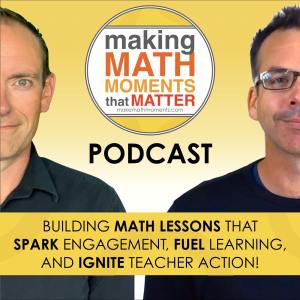
Apply to be a Featured Interview Guest
Book a Mentoring Moment Coaching Call
Are You an Official Math Moment Maker?
FULL TRANSCRIPT
On today’s episode, John, we’re going to share a success story from one of the districts that we’ve been partnering with over the past three years. You’ve been on the journey with them longer than I have, but I’ve had the privilege to work with this awesome team the past year. And I shared with you last week how excited I am about the work that they’re doing this year. And we thought, why not share it with our community?
Yeah, it’s been a journey for sure with this team for a number of years, supporting them on their math improvement plans, starting with, you know, what is their math vision, getting clarity on their math vision, which is stage one, helping them design some objectives. We’ve had some hiccups throughout the time with, say, role changes. This is commonplace inside of our school systems, our district support systems that people come and go.
And partly what we want to stay true is the, is your math improvement planning process? Like the process itself is so important. then for long-term consistency with teachers, because you don’t want teachers to see like another new initiative, another new initiative. So we’ve been establishing, we’ve been building this here in this district, and we’ve got some big wins to share specifically around goals. And I think this is one of the…
When we think about the teams that have gone through the support systems and the support we’ve provided and the four stage process, this flywheel effect process, this operating system that we’re trying to help them install in their school system for long-term sustainability improvement, that it takes this product, the goal setting sometimes is hard, but it’s like there’s pieces happening in the background. There’s work that’s happening. It’s how do we get
more clear on what we’re actually trying to achieve. this team is like getting it, you know, and they’re getting very, very clear. sometimes it takes some time for everyone to learn. We’re not in the, you know, we’re not sitting in the seat to say like, in a way our program isn’t like, you should do this, this, this, this, and this, and this, and you will have success. We’re trying to teach the process to teams so that
that it lives inside a school. we’re helping teams understand how to choose their goals. What does it look like? What are the tools that go into goals? How do you do that at the school level? How do you do that to the district level? How do you transfer that knowledge from the district support to the school, to the teacher? So in a way, this is why this team, we’re seeing such great success at this point in their journey, because we’re seeing that learning
rants from their initial stages a couple years ago into getting more precise every iteration through the process of goal setting. So we still got the same lofty kind of objectives, but we’re getting more clarity and more narrow on what their actual improvement goals look like and the support they’re providing to their teachers. So I’m excited to share some of the specifics, Yvette, where do you want to start?
I think we just also need to set the context for this particular district because, you know, many of the districts that we work with are different. You know, some are small, some are large, some have, you know, different roles at the central office. So this is a large district that we’re supporting and they essentially have two members of the math team at the central office. And one of those members wears many hats. you know, math improvement is not the
only role within their portfolio. And then we have one dedicated math person and they are supported by a team of coaches. The challenge with the coaches that it’s often, the team shrinks and grows every single year and there are new people coming in and off of that team. And so there isn’t as much consistency within the coaching team in this district. Another thing about this large district is that at the central office level,
They are very ambitious forward thinking board. That sounds like a lot of things to me. So that’s like, I want to do everything.
That’s exactly it. It’s like, it’s great to be ambitious and forward thinking and to have vision. But the problem is, you know, the math team in the math department is not the only department with ambition. Sure. And so when you think about we talk about this all the time, you know, the downloading onto the system, you know, of every single team and department has lofty, ambitious, multiple priorities. Think about how taxing that is on the teachers.
That’s why we get our plates overloaded as teachers, right? There’s always this initiative that’s coming, whether we’re focusing on ELA or math or STEM or this new curriculum or maybe we’ve got another initiative around mental health. There’s just a lot coming down on top of our plates that we’re saying, where’s the real, like all of these matter, but then where do, but there’s only so many professional development hours we can attribute.
to the working with teachers, like how many coaches are coming into my classroom? Like where do we actually want to narrow that focus for the teacher herself or himself?
think that you just made a great point, which is that I think the win we’re celebrating for this particular team this year is that because the work is so big and the district is large and there are many moving parts and there’s competing priorities at the central office level, this team has decided to become laser focused this year. And I think that my big takeaway is that
Becoming more narrow doesn’t mean you’re any less ambitious.
Yeah, sounds like it,
Right. You’re like, well, we’re going to do less, but it’s like, no, we’re actually going to do the same amount of work. You know, the work is going to remain the same, but we are positioning ourselves to guarantee change in the short term. And I’m going to say that that’s bold. Like we’ll come back and I will share with you that they’ve set their first milestones for February of this year. So we’ll, you know, commit John to coming back and doing an update episode on whether or not they hit those milestones and how they did it.
but I’m just gonna paint the picture for our listeners. This is a district who initially had three very lofty goals in math. So I think that if I recall correctly, it’s like they had one around mathematical discourse, they had one around fluency, computational fluency, and then they had one around problem solving or accessing tasks with high cognitive demand at grade level.
And then as far as their monitoring, you know, they were looking for a transformative change through their walkthrough or teacher evaluation process. And they had really clearly articulated the change they wanted to see. So this is a team that is well versed in research. They have clarity as a central team about where they want to be five years from now. The vision is there, the areas that they need to strengthen or data for sure.
And that was some of the early work we did.
But what they’re finding is that when it comes to what they can actually commit to, when I got to the end of the year with this team in May, they were burnt out and exhausted. Like they just felt like they were, the lift was too heavy and they weren’t, know, although they knew change was there, they weren’t seeing, you know, the tangible change that they were hoping to see and they were feeling really pulled in different directions.
What were some of the things they were doing to move the needle on those three big long? You know long-term measure or long-term objectives
Right, so they had, for example, a walkthrough look for document that was connected to discourse and their coaches were using that document to provide feedback to teachers. look for document was being presented to principals, so principals were familiar with what we should see around discourse. When it came to computational fluency, they were running after school PD sessions that were voluntary where teachers would come and it was for the purpose of doing math.
explicitly teaching strategies and models that they could leverage in the classroom. I’m trying to think of some other things that they were doing because it was like a laundry list. And then they had some digital platforms that they were implementing around fluency. So in particular grade levels, it was like, we’re going to be introducing this new platform that’s meant to build computational fluency if students get so many minutes a week. And I’m sure there are others that are not coming to mind, but they definitely, nobody wasn’t
working very, very hard. Like the work was there and there was no shortage of work, but there was a shortage of time and energy and focus and you know, getting to the end of the year and feeling like, wow, we worked really, really hard. We did all the things, but now what do we, we’re not necessarily seeing those big transformative changes. And so maybe we start to feel a little bit like what change did we achieve this year?
Yeah, like you can create alignment, because the work between making sure administrators at the school sites know about the objectives and what the look for is for those objectives, how they can work that in to say any sort of the walkthroughs that they’re doing, that’s good work. That’s important work to create alignment across a system. Helping teachers understand what…
high quality instruction around those zones, those three things looks like important work, coaches using the say the look for document with them, important work, aligned work, all great stuff, but it is long term, like it’s one of the, like you’re saying exhausted, it’s cause like we did so much and it’s like, that’s the work we gotta keep doing, you we gotta still do this and like, when are we, the question is like we didn’t,
If we do it a walkthrough now, would we see change? Would we see like this actual improvement? It’s hard to say that because it is consistent work that actually will pay off, but we have to keep doing it. And I think that sometimes where we run the risk, it’s like, yep, we’ve aligned some pieces. We’ve got focus, but what result are we really looking to it to gain? Like we can, we can state the long-term gain, but now we have to wait.
And sometimes we get impatient. And so it’s like, when you get to the year end where this team got to, and I’m so glad that when we were on that call with them, we can help them stay, no, we’re going to keep focusing on these things. We’re just gonna get more narrow so you can see your wins a little bit clearer. Because you can imagine that when we get to that point of the year and we’re like, I feel like we’re doing all these right things, but it’s like,
but I’m not seeing any sort of tangible results yet. So I wanna switch things up. And the switching up is actually going to like throw your flywheel out of place because now we’ve got new, now all of sudden the teacher is getting downloaded new things and it doesn’t feel like the same consistency of what we’re trying to work on. Whereas you know these are the right things to work on. We just have to be, we have to be patient, which is like figuring out what to do while we’re doing the good work. So I think,
you’re saying, I wanna hear you say what some of those specifics are about what the narrowing looked like, because all it took was for them to get a little bit more narrow on what they wanna achieve moving into this year so that they can actually go, I have a tangible result that I can now put under the objective to say, yep, we now know exactly, we’re a little bit closer because of this result to the long-term change.
So keeping in mind, again, the context here, where I mentioned it’s an ambitious board, different departments all having different priorities than they have priorities at the state level, as well as overarching priorities for everybody. One person dedicated to this work, another person wearing many hats. And so we had to get real, right? I think that, again, everybody was working very hard. So the first thing that I asked them,
as we reflected on last year and wanted to make some changes going into the third year was if you look at your three objectives, which one do you think is the most critical change right now? It’s not to say we aren’t going to continue to work on the other two over the next five years, but it’s like imagining that we’re trying to compete with all of these other priorities happening in different departments. We’re downloading onto teachers.
what would be a win for you if you could strengthen one of your objectives and truly strengthen it by the end of next year, which one would it be? And they chose discourse. And the reason that they chose that was twofold. One, was that that’s the critical change they absolutely want to see. Like the people doing the talking or doing the thinking, there is way too much teacher talk time and consistently across their classrooms based on their walkthrough data. It’s like, this is the change that they really, the culture change that they really want to see happen.
now, you know, in the next year. Also, discourse is a board priority. And so they said to themselves, well, if our director and our board of trustees are saying that discourse is a priority across all subjects, let’s double down on it in math. Because then all of the other structures in place, all of the professional development that’s not content specific is also going to strengthen this goal or objective around discourse.
So what we basically did is we said, yes, you have three priorities. Yes, they are all important for achieving the vision that you want, but can we zoom in on one right now? And what we’ve always found about our objective is that like typically when you zoom in on one, the other ones are going to be impacted anyway. It’s almost like, you know, it’s hard to separate them because you’re talking about effective practices, you’re talking about math proficiencies. so
These things are often intertwined just like the rope of the proficiency graphic suggests. So we said, we’re going to really, you know, take our magnifying glass and we’re going to focus in on discourse this year. My next question was, so the team has a very clear vision of what they mean by discourse. They have a look for document. They work with their coaches to clearly articulate, you know, what we’re all aspiring to.
So my next question was, well, what is the critical change that has to happen in the short term to get you closer to that vision? What’s a critical change that you could realistically achieve in the next three, four five months? And so they actually identified two very specific moves and they’re going to measure those moves by February of this year.
The first one is they want to support the implementation of talk routines or collaboration routines. So they want to see the explicit use because we know, we can say turn and talk, but students, and we’ve done episodes on this where there’s a lot of value to routine and structure and predictability for students to feel safe when it comes to engaging in that discourse. So having routines, having sentence stems, having norms established are really important.
So leveraging their coaches and some face-to-face PD time that they have with teachers, they’ve identified five high leverage routines that are actually cross-discipline. So they’re not specific to math, but these are five routines that they’d like to see consistently implemented in classrooms between now and February.
Which means, you know, they’re going to have to provide awareness. They’re going to have to give the teachers opportunity to see it in action. They’re going to need to believe that their students are capable in doing it. And then they’re going to need follow up support. So the coaches, this is their work. Are the coaches going to do other things? Of course they are. They get a plan with teachers. Are they going to moderate? Of course they’re going to do many, but the lens that they’re looking, you know, at their work through is that
They’re a win for them, success for them, is that by February of this coming year, they’re consistently seeing these five or more talk routines implemented in classrooms across subjects. And they’re collaborating with the language arts team and the special education team to be united in this work.
So five strategies consistently utilized in lessons. Coaches are the ones helping them do the four components of adoption, the four pieces, follow up. Like you said, helping them understand the why, understand what this looks like, giving them glimpses. Like I can imagine that, where my head goes immediately is to say, like, how many…
Teachers is that going to be because we know we’ve I think I’ve shared publicly here on the podcast some of the research We’ve dug into we’ve been we’ve been pulling you know There I think anywhere between 30 and 100 hours of professional development are needed to make a change in the classroom in a consistent routine So thinking about I want five routines implemented 30 to 100 I think there’s some other data that suggests like 49 might be that you know a really good number
to say hit towards, but 49 professional development hours between now and February just doesn’t seem real. that, because now you’re saying how narrow do we get? And then we’re talking about a large district. So how are we using the coaches to get more narrow there?
So that’s actually a great question that I didn’t mention, which is they’re only prioritizing grade three to six teachers right now.
go, okay. So now it’s like more realistic. It’s like, okay, we can now double our efforts to like help the coaches go from here to here. Let’s target specific classrooms, target specific teachers to get in there and work with those teachers to implement these types of strategies. So as we know, it takes time. And I think this is the part that I think, and I think we’ve talked about this here on the show before too, is to say, because that feels like too narrow.
Like, wait a minute, what about grade five to six, seven, eight, nine, 10? Like, are we pulling all our coaches from there? And is that okay? That sounds worrisome to some.
And this is the thing, right? People sometimes think that narrow means less ambitious. I just, based on working with so many districts and looking at improvement plans, it’s like, we can go big. But by the end of six months, nine months, 12 months, 18 months, I just don’t know how much traction we’ll have. And so our recommendation always is to go narrow and then leverage.
So go narrow, really build capacity in this group of educators and then position those educators as informal leaders within their building. Give them the opportunity to bring on, know, so the grade three teacher now partners with the grade two teacher and they bring them along for the ride in second semester. And that’s the long-term planning, right? So the idea is that you really focus and build capacity with your grade three to six teachers in semester one. You want tangible evidence that the change has happened.
while also simultaneously identifying your bright spots and your informal leaders who are going to be able to double down on this in semester two to expand to more grade levels. And so I think that we often want to go, we know we say this all the time, like we want to hit as many teachers as we possibly can, but the reality is again, given that math is not the only area we’re trying to strengthen in most districts.
Like there’s other competing work happening simultaneously and so we have to get real about the capacity of our team, the cognitive demand on our teachers that we’re supporting. And if we really think about those, the four stages of the adoption model, what is realistic? And I would much rather see true shift, know, true transformational shift in culture or practice in the classroom through the implementation of these routines.
by February in a third, a fifth, a tenth of my classes that we can then leverage to build more capacity next year than everybody moving a tiny, tiny amount in a way that’s very superficial.
And I think when, let’s say I’m the math coordinator and that makes sense to me. And it’s like, this is the importance of making sure that your team is on board with that commitment. Because a lot of times we just don’t realize that we do need to plan for the four stages of adoption. And if we’re not considering the four stages and the fourth stage accounts for 95 %
of sustainability, like the consistency of happening in the classroom, which is where those 49 professional development actually hours actually come out, is in that consistent follow-up support, individualized coaching support with teachers. And if we’re not factoring that into our narrowed approach or our goal setting, then we’re not actually planning for sustainable long-term change in math classrooms. And I think…
This is why we view this as a huge success story for this district. Either year three of the support, like we said, we’ve had some changes, they are very large, that they’ve gone through this process. In every year, we get a little bit more narrow. It’s partly because that there is resistance to this idea that it takes time for us to realize what it actually takes to create the right changes in our programming.
And we have to learn it. Our principals have to learn it. Our senior administrators have to learn it, like our assistant superintendent or our superintendents have to also be aware that this is actually what’s required and we’re okay. We have to be okay. We have to start planning for what those changes could look like knowing that that’s the plan. So having the team on board is an important part of moving forward.
And sometimes it takes time to go from year one to year two to year three, because remember we’re trying to build this operating system, this systemized approach to saying change. And sometimes that learning, that understanding does take time to progress, to get to a point where we now have a very clear, narrowed approach that will build upon over time instead of spreading, continuing to spread ourselves too thin, because gosh forbid we can’t say,
that we’re only gonna give support to say, great K to three.
And that brings up a good question. And I just want to maybe leave it with this question before we wrap up today. Just because we’re focusing this particular key result around this grade band with these structures in place doesn’t mean we still can’t offer things to all. Right. So and that’s also keeping in mind the capacity of our team. So there might still be, you know, it’s not that everybody else is getting nothing.
There might still be awareness happening in large scale PD. There might be voluntary sessions being offered. We may give teachers access to online courses that they can work through asynchronously or on their own time. There still can be opportunities for all that are maybe low demand on the time of the facilitators because the facilitators need to be able to dedicate their time to the target group and the target key results for this timeframe.
Totally, but I think what we are recommending here is plan for the narrowed time first, like fill that jar first so that when you get to the other part, you now know that we’re gonna have a dedicated focus here, we’re gonna get that result by blank, and then any spillover happens for all. And we are gonna plan for all, but we do wanna make sure like, what is the capacity for that key result? Now, here’s the other thing we’ve done with other teams too, is that,
When we get narrow with one key result, we still feel like, okay, we feel like we have capacity to hit that key result and do another one. And we’re gonna say, work on with this over here and work on that. And we’ve narrowed down, we’ve gone through the processes, we’ve done the if, then how framework, we’ve built this very comprehensive plan to hit that key result with all of the time commitments and the schedules that may go into it. And we still have time to plan for everybody else.
because of the way that we’re structuring that and that some of that guidance comes along, know, this is some of the guidance we’re doing to help kind of narrow those things and develop those plans help with that part. But, but fill one, like we’d rather you see go narrow, fill the jar here and then take a step back and go, what else can we do? Because maybe you’ll see that you’ve already filled the jar, but then now you’ll, you’ll know that that’s all you have to stick to and you will get the result that you want because you’re, you’ve understood what is required to hit a key result.
If you’re unsure of what those pieces are, if you’re unsure of like what this looks like, we’d be glad to hop on a call with you to kind of walk you through, you know, what those four stages look like. What are the pieces that you could be doing? Cause every district that we’ve, we’ve worked with always has their unique constraints, unique, unique, different pieces and different things. We’ve done this lots of places, lots of, lots of different sizes of organizations. And every time we still install the same
four stages, but it looks different for every team. And it always starts with that first call, that call that we hop on with is to see what does this look like for you? What does this support? What have you done in the past? What can we build upon so that you now have a sustainable math improvement plan moving forward? That’s that first step is hop on that call with us. We do have some space available still, so head on over to makemathmoments.com forward slash district.
Book a call with us and we can talk about what your next steps could be.
Thanks For Listening
- Book a Math Mentoring Moment
- Apply to be a Featured Interview Guest
- Leave a note in the comment section below.
- Share this show on Twitter, or Facebook.
To help out the show:
- Leave an honest review on iTunes. Your ratings and reviews really help and we read each one.
- Subscribe on iTunes, Google Play, and Spotify.
DOWNLOAD THE 3 ACT MATH TASK TIP SHEET SO THEY RUN WITHOUT A HITCH!
Download the 2-page printable 3 Act Math Tip Sheet to ensure that you have the best start to your journey using 3 Act math Tasks to spark curiosity and fuel sense making in your math classroom!
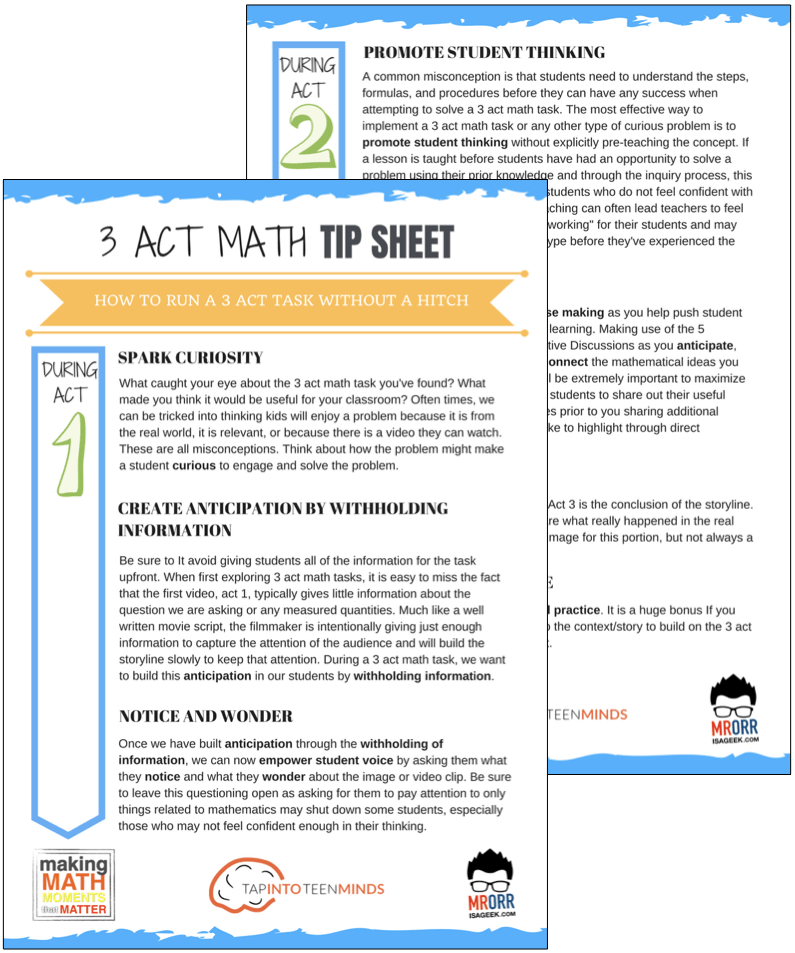
LESSONS TO MAKE MATH MOMENTS
Each lesson consists of:
Each Make Math Moments Problem Based Lesson consists of a Teacher Guide to lead you step-by-step through the planning process to ensure your lesson runs without a hitch!
Each Teacher Guide consists of:
- Intentionality of the lesson;
- A step-by-step walk through of each phase of the lesson;
- Visuals, animations, and videos unpacking big ideas, strategies, and models we intend to emerge during the lesson;
- Sample student approaches to assist in anticipating what your students might do;
- Resources and downloads including Keynote, Powerpoint, Media Files, and Teacher Guide printable PDF; and,
- Much more!
Each Make Math Moments Problem Based Lesson begins with a story, visual, video, or other method to Spark Curiosity through context.
Students will often Notice and Wonder before making an estimate to draw them in and invest in the problem.
After student voice has been heard and acknowledged, we will set students off on a Productive Struggle via a prompt related to the Spark context.
These prompts are given each lesson with the following conditions:
- No calculators are to be used; and,
- Students are to focus on how they can convince their math community that their solution is valid.
Students are left to engage in a productive struggle as the facilitator circulates to observe and engage in conversation as a means of assessing formatively.
The facilitator is instructed through the Teacher Guide on what specific strategies and models could be used to make connections and consolidate the learning from the lesson.
Often times, animations and walk through videos are provided in the Teacher Guide to assist with planning and delivering the consolidation.
A review image, video, or animation is provided as a conclusion to the task from the lesson.
While this might feel like a natural ending to the context students have been exploring, it is just the beginning as we look to leverage this context via extensions and additional lessons to dig deeper.
At the end of each lesson, consolidation prompts and/or extensions are crafted for students to purposefully practice and demonstrate their current understanding.
Facilitators are encouraged to collect these consolidation prompts as a means to engage in the assessment process and inform next moves for instruction.
In multi-day units of study, Math Talks are crafted to help build on the thinking from the previous day and build towards the next step in the developmental progression of the concept(s) we are exploring.
Each Math Talk is constructed as a string of related problems that build with intentionality to emerge specific big ideas, strategies, and mathematical models.
Make Math Moments Problem Based Lessons and Day 1 Teacher Guides are openly available for you to leverage and use with your students without becoming a Make Math Moments Academy Member.
Use our OPEN ACCESS multi-day problem based units!
Make Math Moments Problem Based Lessons and Day 1 Teacher Guides are openly available for you to leverage and use with your students without becoming a Make Math Moments Academy Member.
Partitive Division Resulting in a Fraction
Equivalence and Algebraic Substitution
Represent Categorical Data & Explore Mean
Downloadable resources including blackline masters, handouts, printable Tips Sheets, slide shows, and media files do require a Make Math Moments Academy Membership.
ONLINE WORKSHOP REGISTRATION
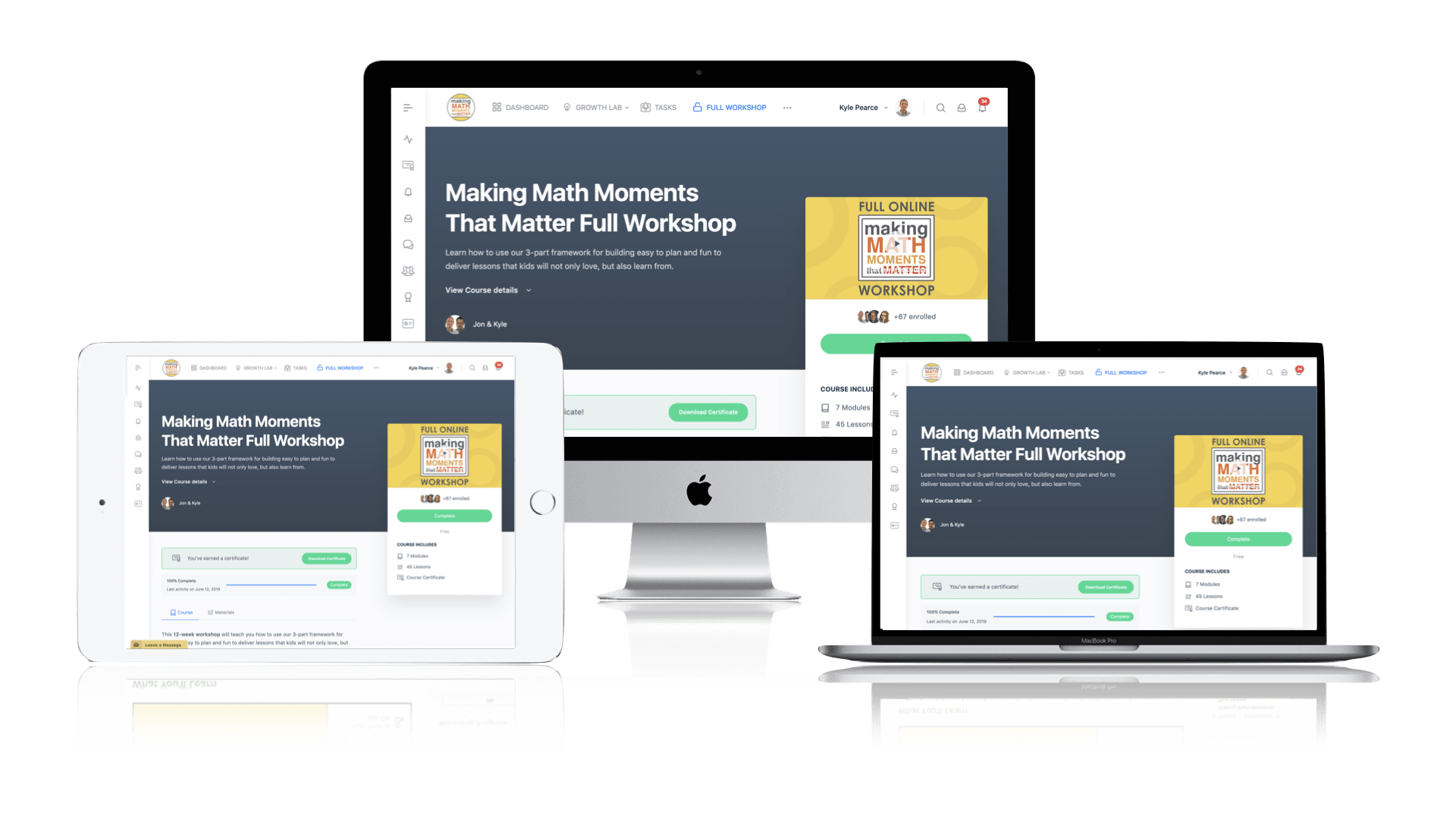
Pedagogically aligned for teachers of K through Grade 12 with content specific examples from Grades 3 through Grade 10.
In our self-paced, 12-week Online Workshop, you'll learn how to craft new and transform your current lessons to Spark Curiosity, Fuel Sense Making, and Ignite Your Teacher Moves to promote resilient problem solvers.
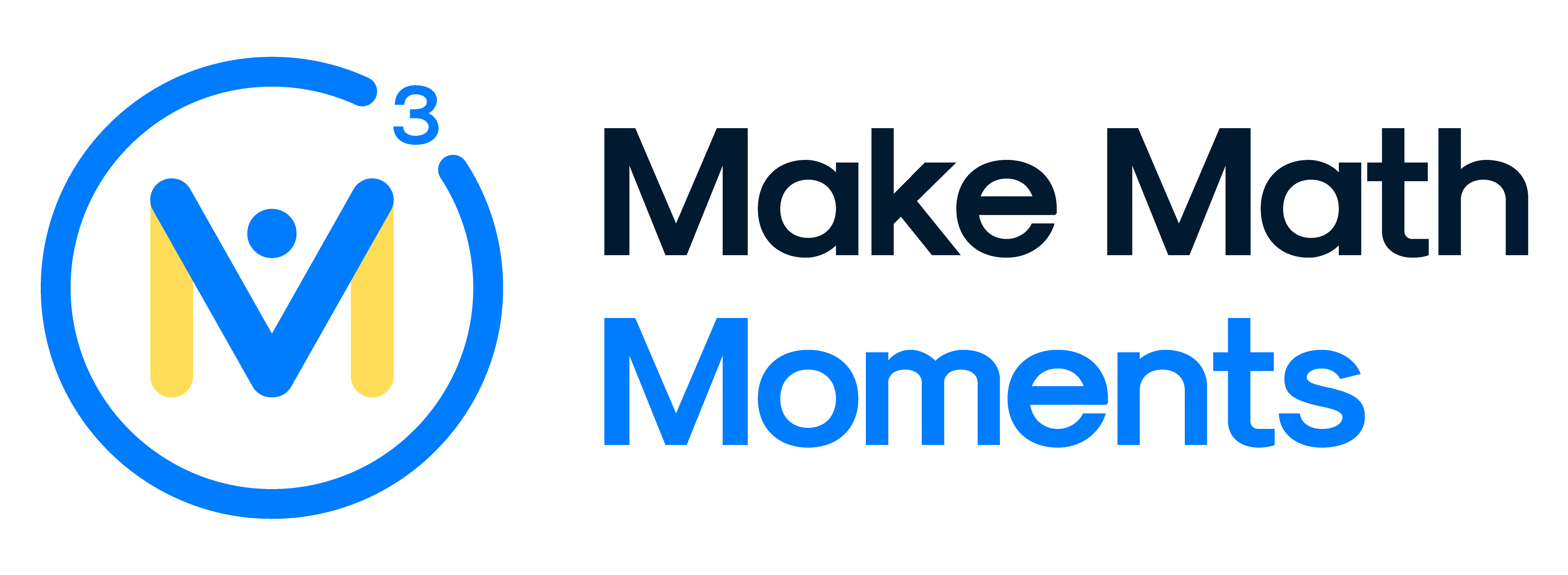



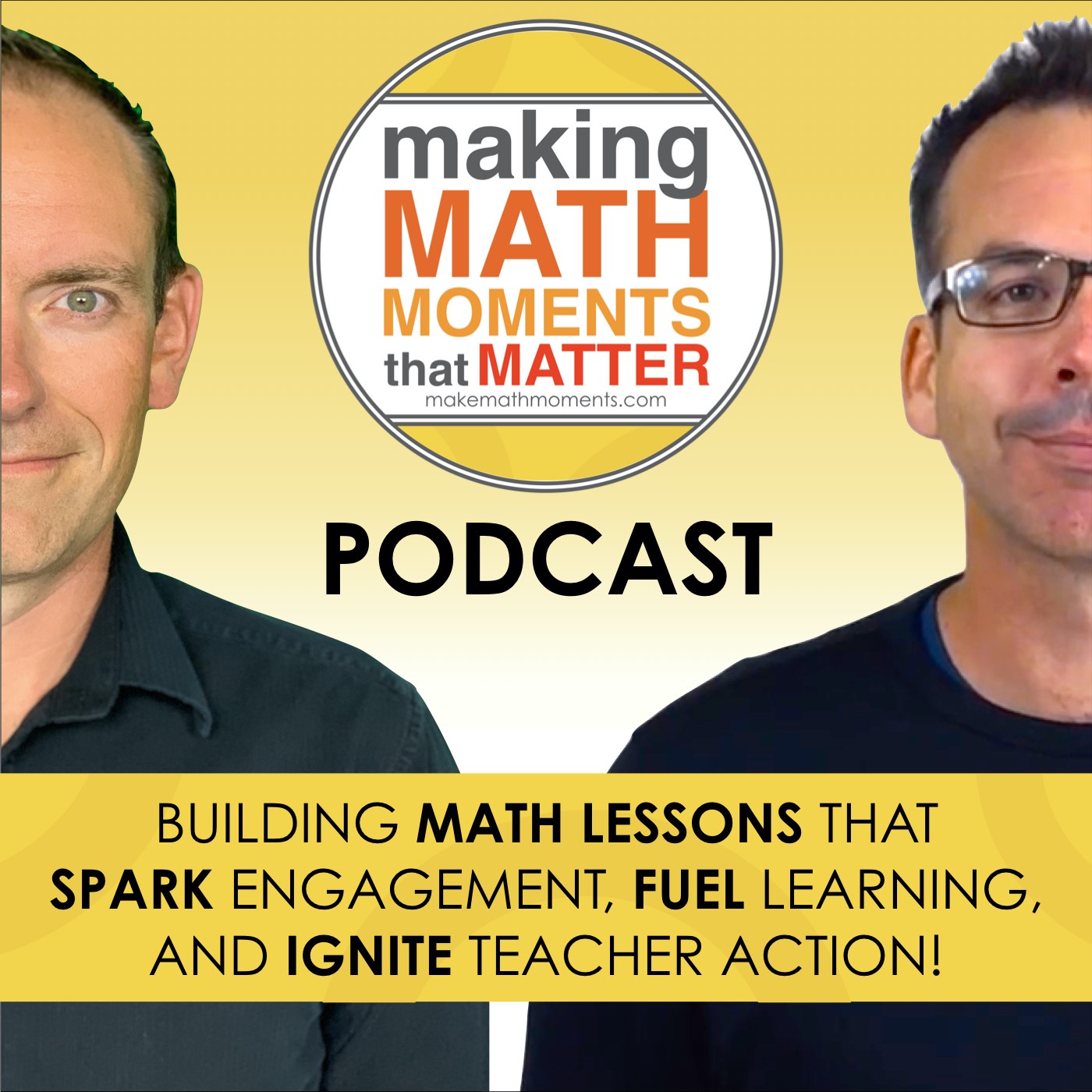
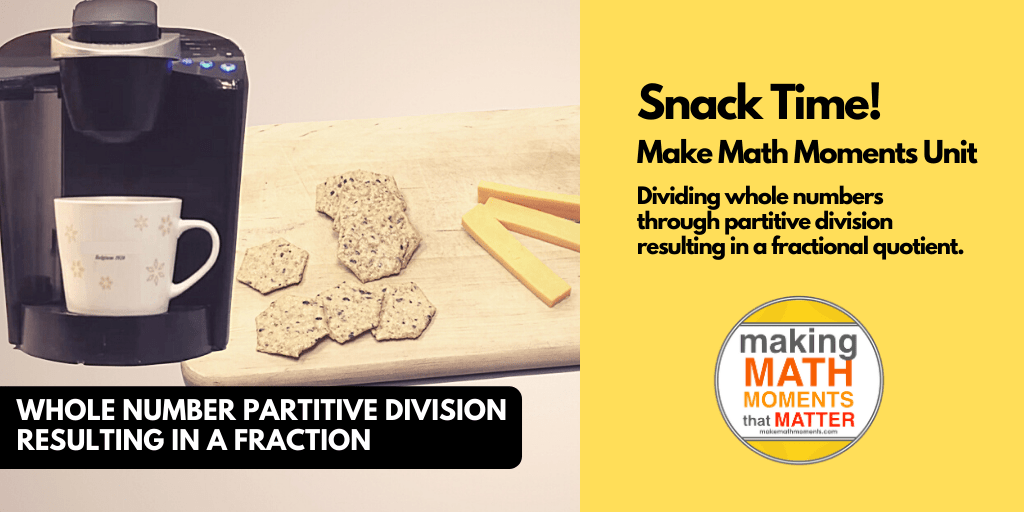

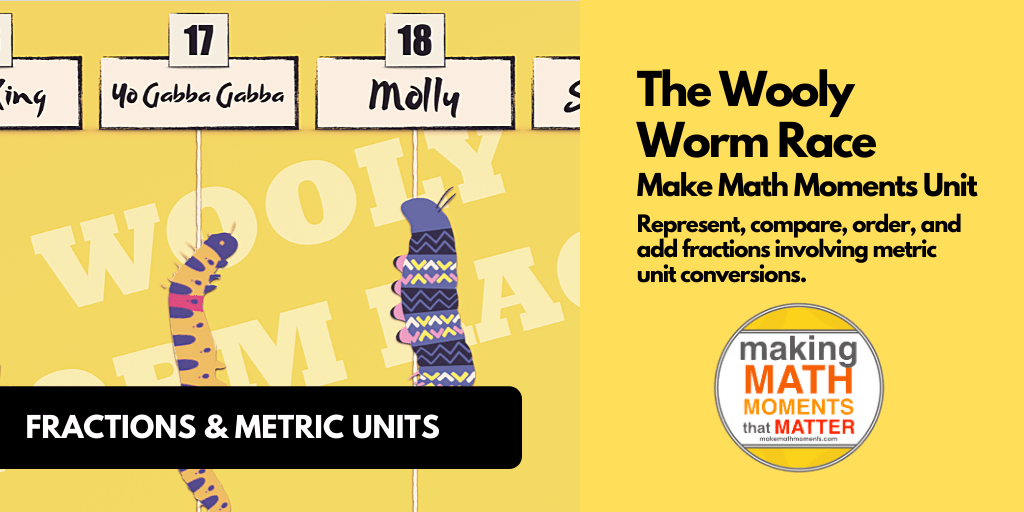
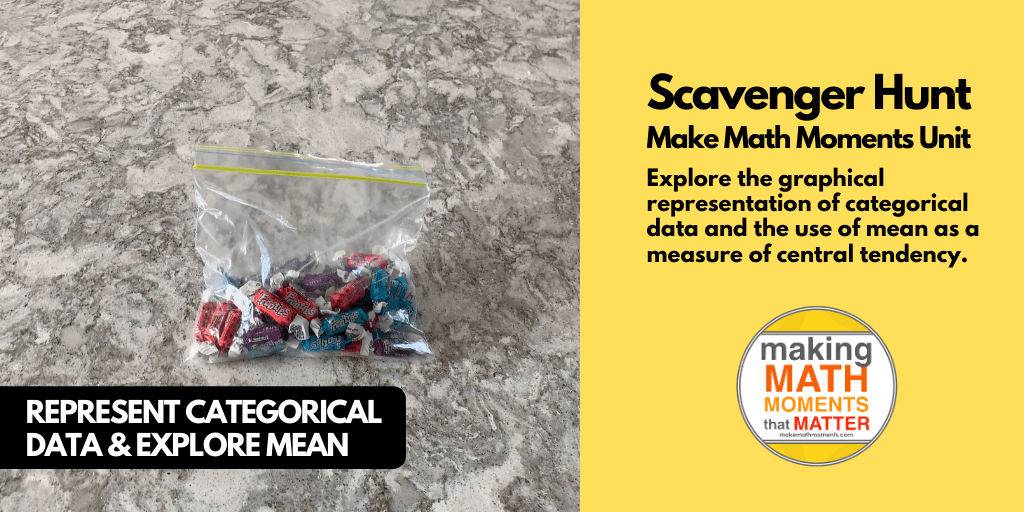
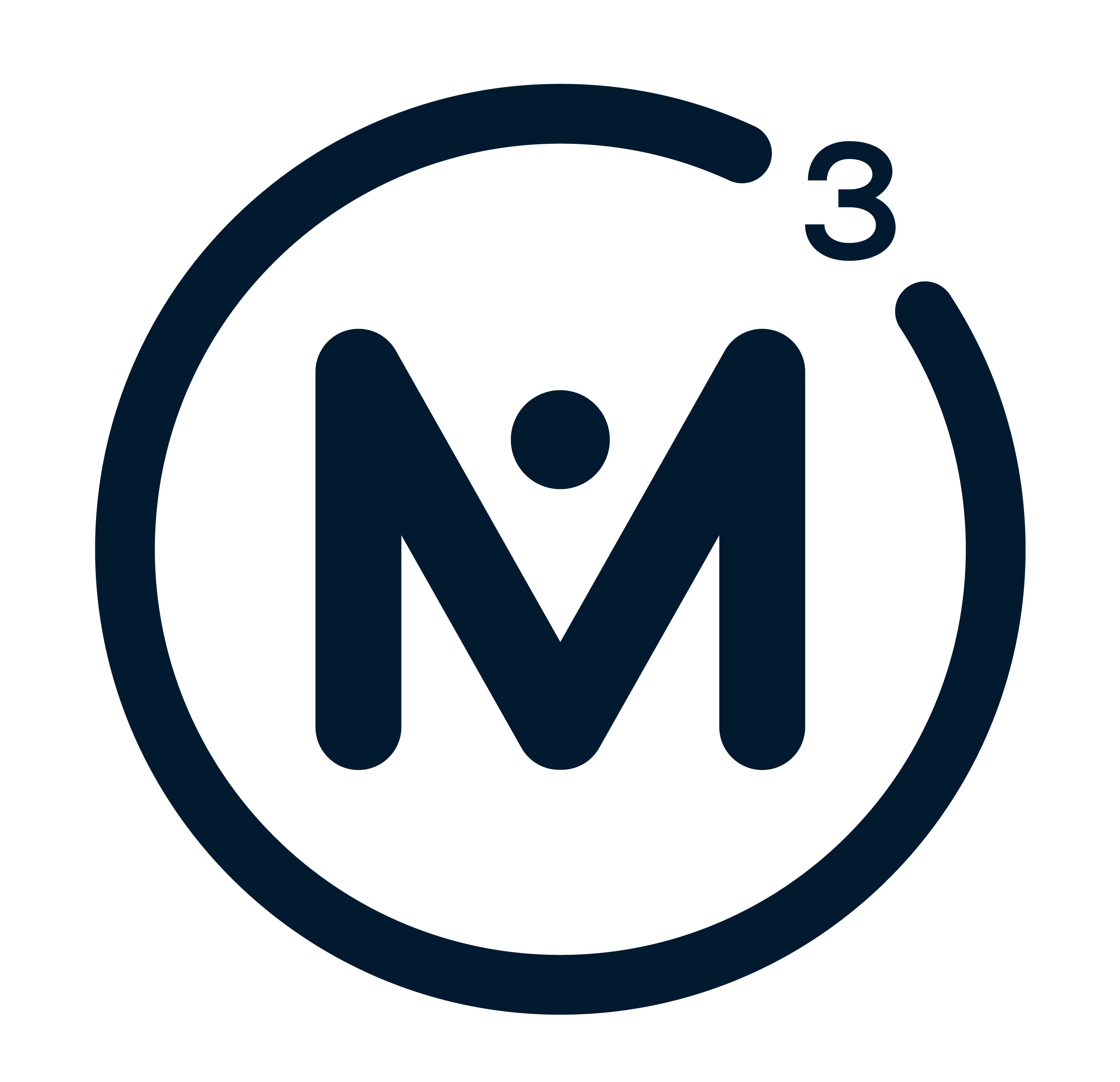
0 Comments